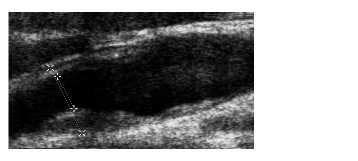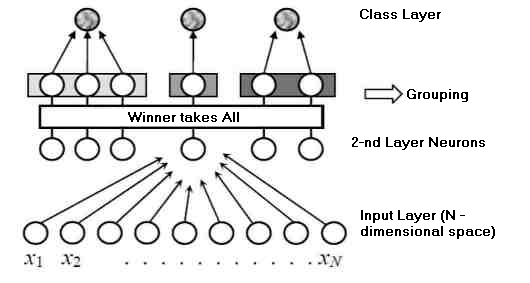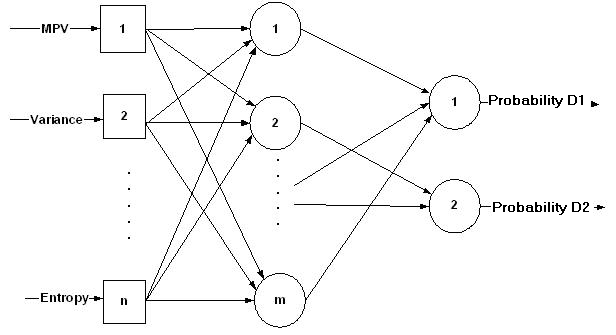|
- INTRODUCTION
- REVIEW ON SUBJECT
- OBTAINED AND EXPECTED RESULTS
- SUMMARY
- REFERENCES
I. INTRODUCTION
1.1 Actuality of the work
The cerebral pathology occupies one of the leading places in the structure of death and invalidition rate of the population that determines it as one of the major medical and social problems. [1].
Patients, who have stenosis of a carotid less than 70 %, also suffer with sharp brain blood circulation infringements. But in this case hemodynamic infringements are not the main reason of occurrence of blood circulation infringement in brain. Insults in such cases develop as the result of embolism from broken up atherosclerotic lesions into a mouth of internal carotids. Therefore exact definition of the source of embolism (of unstable atherosclerotic plaque) is a pressing question.[1]
Now there is an opportunity to carry out high-grade ultrasonic researches with visualization of walls of a vessel using ultrasonic scanner in the В-mode. These researches can be effective and sufficient in producing of the diagnos. [1].
1.2 The objectives and problems of the work
The purpose of master's works is the construction of specialized computer system for an estimation of a condition of an atherosclerotic plaque with the purpose to reveale its embolism possibility on the basis of the results of ultrasonic research (doppler measurement mode and B-scanning mode).
According to the objective of the master's work, the following problems have to be solved:
-
choice of an optimum set of significant quantitative attributes of the US images, which will allow to judge about embolism possibility of an atherosclerotic plaque (for example, on the basis of the statistical analysis);
-
choice of methods of preliminary processing of the US images to increase the resolution possibility of considered quantitative attributes;
-
choice of the optimum qualifier from the point of view of 1) accuracy of carried out classification, 2) opportunity to extrapolate decisions for new images, 3) speed of work, 4) speed of training (for neural networks), 5) necessary memory size, 6) representation of the entrance and target data (in a binary kind, as continuous values, as posibility estimations).
Stages, being followed by the computer system, while defining the unstable atherosclerotic plaque:
-
reception of the initial ultrasonic image of the atherosclerotic plaque from the US scanner;
-
preliminary processing of the image (normalization of the image histogram, contrasting, filtration);
-
formation of boundaries of the atherosclerotic plaque manually by the operator;
-
calculation of numerical values of attributes of the allocated structure, reception of a N-dimensional vector of entrance attributes;
-
application of the qualifier for atherosclerotic plaque type identification; the entrance data is the N-dimensional vector of attributes received at the previous stage.
The processing algorithm of the computer system, being developed, is illustrated as animation, see below. The first frame shows the ultrasonic image of a gleam of a vessel and atherosclerotic plaque, which can be seen on the bottom wall of the vessel. The second frame shows the segmented plaque and the process of extraction of statistical and textural features from the allocated fragment of US image. The third frame shows, that the evaluated features serve as input values for the probabolistic neural network, that acts as the qualifier. The fourth frame shows the result of PNN work - an estimation of the possibility, that plaque belongs to one of two definite types.

1.3 Practical value of the work
Nowadays judgment of the doctor for making decision on danger of atherosclerotic lesion of a vessel is used in clinical practice. In case when stenosis of an artery with an atherosclerotic plaque is more than 70% the decision on surgical intervention (with the purpose of plaque removal) is made. However danger of plaque embolism exists also when the stenosis is less than 70%. So the practical value of the designed computer system consists in definition of embolism possibility at a stenosis less than 70 %, in revealing of unstable (inclined to break) plaque. This will help the doctor to maintain the diagnosis.
The scope of the developed specialized computer system includes tool diagnostics directed on: 1) early revealing of unstable atherosclerotic lesions of cerebral arteries at various clinical stages; 2) identification of symptomatic and asymptomatic plaques. The received results can be of great importance for decision-making on surgical intervention with the purpose of removal of "dangerous", unstable plaque.
II. REVIEW ON SUBJECT
2.1 Local review
The subject, devoted to methods of diagnostics of vascular diseases, is present in publications of prof., d.t.s. Skobtsov Y.A. and his scientific school - [2],[3],[4],[5],[6].
Methods of the analysis of ultrasonic images with use of various textural attributes and with application of artificial neural networks are examined in the articles of prof., d.t.s. V.G.Adamov and c.t.s. M.V.Privalov - [7], [8].
Also at a local level of a magistracy the similar subjects or methods are present in works [9] - "The development of the specialised computer system for the diagnostics of the lipid embolism", [10] - "The development of specialized computer system for modelling of gemodynamic structure of the human arterial channels", [11] - "The development of automated system applied to image texture recognition using rotation and scale invariant methods".
2.2 National & Global reviews
There are works of the following authors in the field of the researched question at the national level:
prof. Volkov V.I. - researches of atherosclerotic lesions, its formation, clinical displays and treatment [12];
M.I.Lutay, A.N.Lomakovskiy - researches of morfological characteristics of unstable atherosclerotic lesions of the heart arteries [13];
A.V.Gudzikevich, V.A.Ezhov - researches of power of ultrasound diagnostics of microembolism in cerebral pathology [14];
d.m.s. Lushik U.B. - patented method of ultrasound diagnostics of cerebral vessels condition [15];
At present moment at a global level in the field of a researched question there are works on classification of atherosclerotic plaques according to ultrasonic research in a В-mode, executed by Reilly L.M. et al. (1983) [16] and Gray-Weale A.C. et al. (1988) [17]. These works underlie all classifications available on today. In works [18], [19], [20] researches were hold with the purpose to find out other ultrasonic criteriaes for classification of atherosclerotic plaques and for revealing of its embolism possibility, besides the criteria described in [16] and [17].
In work by Marie-Louise M. Gronholdt [21] a comparison of investigation results of different authors, who studied connections between values of ultrasonic criteria (such as low or high echogeneity, homogeneity or heterogeneity of atherosclerotic plaque, average gray tone value of the ultrasonic image) and estimation of risk of occurrence of symptomatic attributes, is carried out.
In work [22] application of qualifiers on the basis of the machine of basic vectors (МВV) and probabolistic neural networks (PNN) for realization of classification of atherosclerotic plaques on two types – asymptomatic and symptomatic, using thus morphological attributes, is described.
In work [23] it has been shown, that the descriptors, evaluated on the basis of textural spatial gray level dependence matrix (SGLDM), have allowed to divide atherosclerotic plaques into two classes in the best way, compared with other textural features (% of correct classification was 72.2%).
III. OBTAINED AND EXPECTED RESULTS
At the present development stage of specialized computer system the following results, connected with 1) the choice of the quantitative textural attributes allowing to divide various classes of atherosclerotic plaques in the best way depending on their embolism possibility, and 2) the choice of the qualifier for atherosclerotic plaque definition, are received.
1. The choice of textural features
For the majority of natural images only small set of features is informative, and it is various for each separate problem, faced by the researcher. Therefore there is a task of an adaptive choice of the most informative attributes.
Based on the results of the above mentioned researches, the conclusion has been made, that for objective classification of atherosclerotic plaques as inclined to break, it is necessary to use the criteriaes which take into account all possible combinations of histologic structure of the plaque, i.e. it is necessary to include such following attributes into consideration:
-
average gray tone value (classification on hypo- and hyperechogeneity) (in case of k=1 in equition):

a standard deviation of mean gray tone value and the descriptor of relative uniformity (smoothness) of the image calculated on its basis (R):

- minimum gray tone value (control point of gleam of a vessel);
- maximum gray tone value (control point of wall of a vessel);
- entropy:
E = - SUM[p(zi)*log2p(zi)], i = 0, ... L-1
Entropy is a convenient measure describing behaviour of a random variable (through its distribution) from strict determinancy up to full randomness. Its application is especially useful in case of asymmetric and-or multimodal distributions, when use of such numerical characteristics as average value, standard deviation and the moments of supreme orders, loses any representative view. [24].
statistical measures of Gray Level Difference Statistics (GLDS) - contrast (CON) and angular second moment (ANSM):


statistical measures of spatial co-occurrence matrix (SGLDM – Spatial Gray Level Dependence Matrix):



Expression T1 describes the angular second moment, that is a measure of uniformity of a structure. Equition T2 defines contrast of the image. Contrast is the differential moment of a matrix of co-occurrence and states a quantitative estimation of local changes of the brightness present in the image. The parameter set by T3 is the correlation being a measure of presence of gray tone linear dependence in the image. Parameter Т4 determines entropy for SGLD matrix - a textural attribute for plaque classification on homo-, heteroechogeneity.
spectral broadening index (SBI) which is a measure of turbulence of blood stream in the area of plaque localization:

где: PS – maximum sistolic velocity;
TAMn – averaged on time average-on-capacity speed.
It has been shown in article [18], that breaking of the cover of the atherosclerotic plaque is frequently connected with physical loading, strengthening of intimate reductions, stretching of a wall of a vessel. Therefore, it is logical to assume, that the risk of plaque cover break also increases at high values of turbulence of blood stream in the area of plaque localization.
For a choice of a concrete feature set it is required to execute researches of their resolution at processing of ultrasonic pictures.
The following expression can be used as a measure, which shows ability of features to distinguish 2 different classes:

The more received value is, the better the given feature distinguishes 2 classes of images between themselves.
2. The choice of the classifier
• Case, when there is SOME aprioristic knowledge of vectors of textural features of training set belonging to the certain plaque class
The first way – is the use of the statistical qualifier К-nearest neighbours.
Another way – is the use of artificial neural network (NN) of forward propagation, which is trained with the supervisor.
• Case, when there is NO aprioristic knowledge of vectors of textural features of training set belonging to the certain plaque class
In this case firstly it is required to divide initial set of feature vectors on clusters in N-dimensional space, where N – is the dimension of feature vectors. For this task the artificial NN trained without teacher – Kohonen’s neural network and increased self-organizing structures (incremental self-organizing feature maps) [25] - are used, fig. 1.

Figure 1 - Incremental self-organized neural network
The NN with incremental self-organizing structure is more flexible and adaptive, than Kohonen’s network, since the quantity of clusters necessary for classification is defined during training, instead of setting it prior to the beginning of training.
The next step in designing of the qualifier is maintaining of the PNN – probabolistic neural network. Advantage of PNN is that target value has probabolistic sense (and is easier to interpret), and that the network is quickly trained.
The possible version of PNN topology is resulted in the fig. 2:

Figure 2 - Probabolistic neural network topology
Each element in the first layer represents one quantitive feature, extracted from one image (observation). Second layer consists of nodes, which quantity is equal to the quantity of training feature vectors, extracted from training images (observations). Each node is a radial gaussian element with the center in the point in the N-dimensional space, defined by one N-dimensional feature vector.
Each target element (class or diagnosis) in the third layer is connected only to those radial elements from the second layer, which represent an observation of this definite class (type), and with all other elements it has zero connection.
Due to ability of self-organization, ISOM and Kohonen’s networks can divide a training set of images (observations) on clusters, and so providing data that is needed to connect the second and target layers of the PNN.
IV. SUMMARY
The following summary can be made:
-
None of the existing methods can offer the uniform, conventional way or criterion for definition of propensity of atherosclerotic plaque to break. Creation of diagnosing system on the basis of the complex criterion reflecting all attributes of plaque embolism is the task to be solved in future.
-
Comparison of 1) results of histologic researches in vitro (investigation of the plaque structure) and 2) results of ultrasonic researches in vivo (analysis of the plaque image received from ultrasound scanner and analysis of textural descriptors, evaluated on the image basis) has to be carried out for reception of set of the most informative quantitive textural descriptors, that can authentically establish the risk of breaking of atherosclerotic plaque.
-
Realization of atherosclerotic plaque classification on types depending on its propensity to break (for example, steady, inclined to the break, inclined to break at external influences) is a challenge since there is no precise functional connection between data, received as the result of the research, and the valid event. In absence of an opportunity to put the unequivocal diagnosis, it is possible to resort to a paradigm of estimation of event probability (with the help of probabolistic neural network).
Notation: The above printed text of the abstract of master’s work is not its final version, since
the ending of the researches' work is planned by 31.12.2007. For reception of the full version of
the abstract please send inquiry to the address:
mvlad@icm.dn.ua
V. REFERENCES
-
http://www.promeds.ru/states.php?iid=470&id=5
-
Ю.Скобцов, В.Оверко, Ю.Родин, В.Скобцов, В.Гринь, А.Штутин Исследования поведения потоков крови и компьютерная диагностика сосудистых заболеваний // Энергия инноваций. - 2005. - №2-3. - С.40-42. (0.3д.а.)
-
Ю.Скобцов, В.Оверко, Ю.Родин Моделирование и визуализация потоков крови в сосудах с различной патологией // Праці Першої міжнародної науково-технічної конференції «Моделювання і комп’ютерна графіка», 04-07 жовтня 2005, Донецьк. (0.5д.а.)
-
Ю.В.Родин. Влияние характеристик атеросклеротической бляшки и факторов риска на вероятность тромбоза внутреней сонной артерии// Вестник неотложной и восстановительной медицины – 2005. – №4. – С.565-570.
-
Ю.А.Скобцов, В.С.Оверко, Ю.В.Родин, В.К.Гринь, А.А.Штутин, В.В.Пичка. Исследование потоков крови при патологической S-образной извитости сонных артерий// Труды Института прикладной математики и механики НАН Украины.-Донецк:2006. ИПММ .-Том 12 с.164-171.
-
Скобцов Ю.А., Родин Ю.В., Озерко В.С. Исследование и визуализация поведения потоков крови в ветвящихся сосудах// Вестник Херсонского национального технического университета.- Херсон:2006.-№1 (24).-с.50-54.
-
http://dgma.donetsk.ua/~ek/sc/neyro2002/2002/art17.htm
-
http://nich.donntu.ru/konf/konf4/sek_07_informat/s07_05.pdf
-
http://masters.donntu.ru/2006/kita/garipov/diss/index.htm
-
http://masters.donntu.ru/2006/kita/chvala/diss/index.htm
-
http://masters.donntu.ru/2006/kita/varshavskaya/diss/index.htm
-
http://www.is.svitonline.com/avizenna/Web/Volkov.htm
-
http://www.rql.kiev.ua/cardio_j/2005/2/lutay.htm
-
http://www.ultrasound.net.ua/page/text/name=udk9-11
-
http://www.lushchyk.org.ua/rindex.htm
-
Reilly L.M., Lusby R.J., Hughes L. et al. Carotid plaque histology using real-time bitrasonography. Clinical and therapeutic implications // Am. J.Surg. 1983. V.146.№ 2. P.188-193.
-
Gray-Weale A.C., Graham J.C., Burnett J.R. et al. Carotid artery atheroma: comparison of preoperative B-mode ultrasound appearance with carotid endarterectomy specimen pathology // J. Cardiovasc. Surg. 1988. V. 29. № 6. P. 676-681. Источник: Дубров Э.Я. и др. Ультразвуковая и функциональная диагностика. 2006. №1. С.97-103
-
И.Дж. Калло, В.Д. Эдвардс, Р.С. Шварц Механизмы и клинические проявления разрывов атеросклеротических бляшек - Translated with the permission of the ACP—ASIM, from: Kullo I.J., Edwards W.D., Schwartz R.S. Vulnerable plaque: pathobiology and clinical implications. Ann Intern Med 1998;129:1050—60.
-
C.I Christodoulou, E. Kyriacou, M.S.Pattichis, C.S. Pattichis, A. Nicolaides, “ A Comparative Study of Morphological and other Texture Features for the Characterization of Atherosclerotic Carotid Plaques”, Proc of CAIP 2003, The Nederlands, 165-173, (2003).
-
Oliver M. Jeromin, Marios S. Pattichis, Constantinos Pattichis, Efthyvolous Kyriacou, Andrew Nicolaides “Variogram Methods for Texture Classification of Atherosclerotic Plaque Ultrasound Images”, University of New Mexico, Albuquerque, New Mexico, USA; University of Cyprus, Nicosia, Cyprus; Imperial College of Medicine, London, UK.
-
Marie-Louise M. Gronholdt "Ultrasound and Lipoproteins as Predictors of Lipid-Rich, Rupture-Prone Plaques in the Carotid Artery” Arterioscler. Thromb. Vasc. Biol. 1999;19;2-13.
-
E. Kyriacou, C.S. Pattichis, M.S. Pattichis, A. Mavrommatis, S. Panagiotou, C.I. Christodoulou, S. Kakkos, A. Nicolaides “Classification of Atherosclerotic Carotid Plaques Using Gray Level Morphological Analysis on Ultrasound images”, Proc. of Medicon 2003, Ischia, Naples, Italy, August 2003.
-
C.I. Christodoulou, C.S. Pattichis, E. Kyriacou, A. Nicolaides, “Selection of Parameters for Texture Analysis for the Classification of Carotid Plaques”, Proc. of Medicon 2004, Ischia, Naples, Italy, August 2004.
http://www.medinfo.cs.ucy.ac.cy/documents/Medicon04_Christodoulou-CI.pdf
-
Яншин В. В., Калинин Г. А. «Обработка изображений на языке Си для IBM PC: Алгоритмы и программы» — М.: Мир, 1994. — с, ил. С. 96-101.
-
Z. Iscan, M.N. Kurnaz, Z. Dokur, and T. Olmez “Ultrasound Image Segmentation by Using Wavelet and SOM”, Neural Information Processing - Letters and Reviews, Vol. 10, Nos. 8-9, Aug.-Sept. 2006.
http://ieeexplore.ieee.org/iel5/9009/28608/01279845.pdf
|


